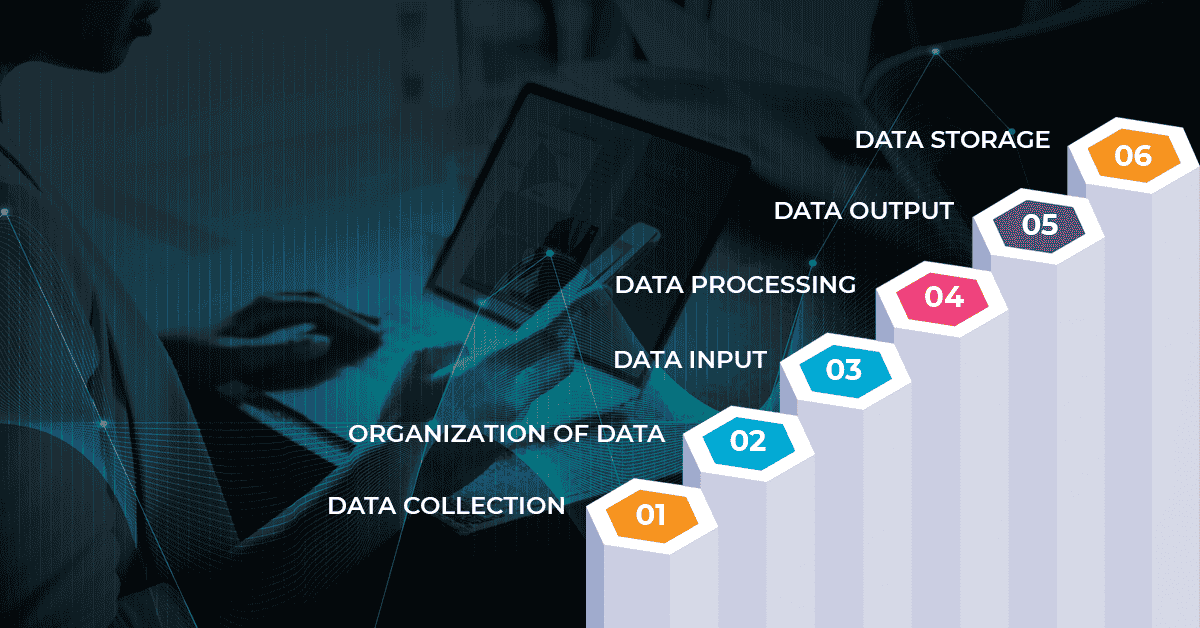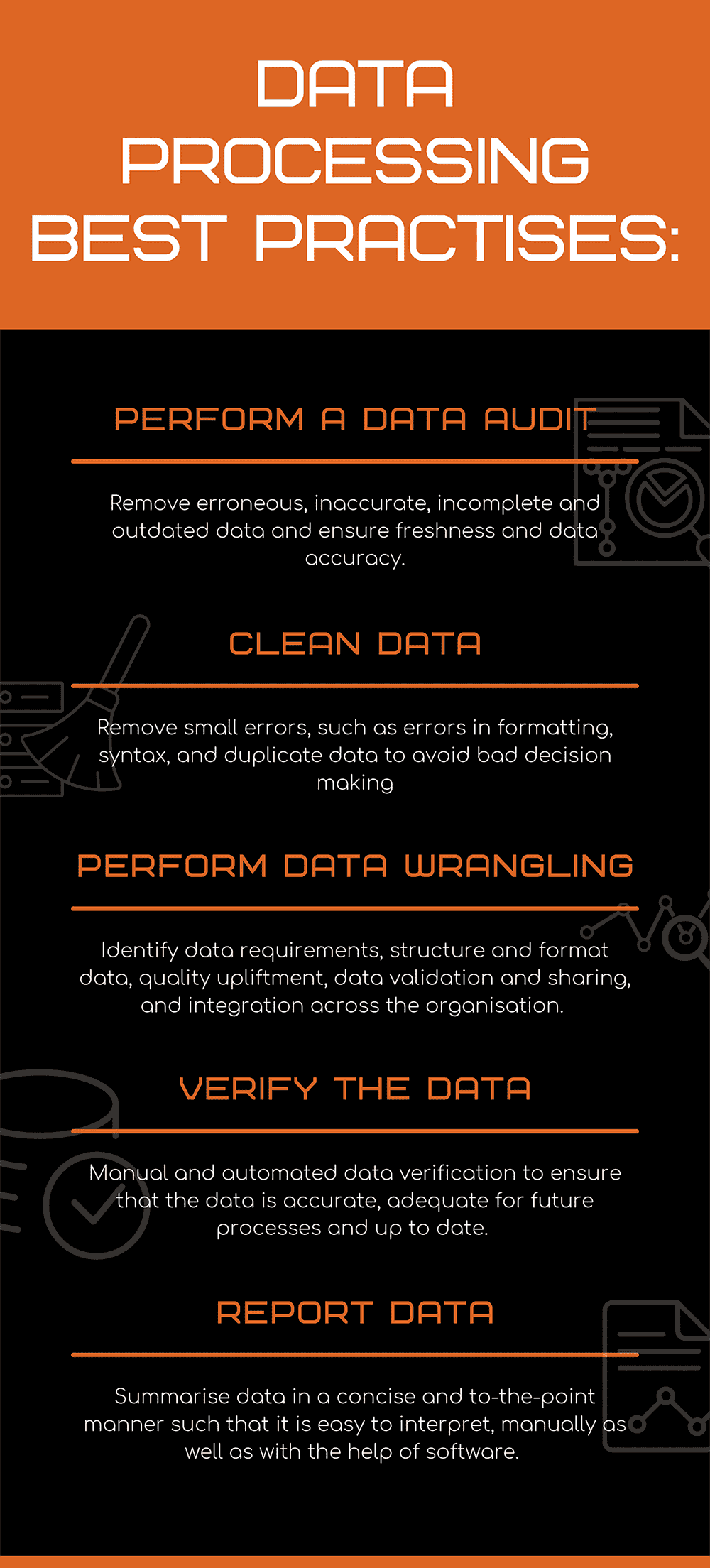
Meaning of Data Processing
Data processing services are being used around the world by businesses to utilise their data in the best way possible. It basically involves converting raw data to more usable data. The processed data can be used to predict forecasts and help in high level and long term decision making as well.
When dealing with big data, it is a complex process that involves a great amount of technical expertise. There are various stages involved with data processing, from cleansing to processing analysis to the transfer of data. There are many tools available in today’s time to carry out data processing services.
However, it also involves decision making by data experts such as engineers and scientists. This is because business, data, and market trends keep evolving by the day and the value of human innovation and experience is really significant. Hence, a perfect combination of man and machine intelligence results in the best data processing solutions.
Data analysis is another important function related to data processing. It involves the use of algorithms to create forecasts on the basis of current data. This is one of the most important data processing solutions as it can help businesses thrive with the sheer help of data, even when facing stiff competition.
The Importance of Data Processing Services in Business
Data processing services have several uses and applications in all kinds of businesses, from startups to large scale multinational organisations. Its most significant advantages are data privacy and security, ease of operation, and the return of investment in terms of profits.
- All kinds of data can be processed, be it in the form of graphs, surveys, Excel sheets, spreadsheets, forms, etc. While data might be available in different forms, data processing streamlines business operations by converting it into manageable and usable formats.
- Records of financial transactions can be analysed, stored, and utilised to study the flow of money within an organisation. This helps make key business decisions and also helps businesses manage money better.
- Big businesses usually deal with large amounts of data and managing it can be quite a hassle. Data processing solutions can help manage big data in the most efficient way while ensuring data security.
- The data involved with organisations such as banks and hospitals is quite critical and needs to be handled carefully. This involves not only collection and analysis but processing to help decision making for the future. Data processing solutions ensure the entire process is carried out smoothly, helping such critical sectors in the best way possible.
Data Processing: Stages and Methods
Data processing has several stages and methods. Data might be available in the form of orders, mailing lists, forms, market research forms, images, credit cards, surveys, insurance claims, etc. While the data might be available in different formats, the workflow remains the same.
Regardless of the data type and format, there are a few common stages of data processing – data collection, organisation, data input, processing, output, and storage. It is essential to study each stage in detail before knowing about the best practices.
1. Data Collection
Data collection is the first and perhaps one of the most crucial stages of data processing. If data isn’t collected appropriately, the whole process is bound to go haywire. Data is collected from warehouses, systems, and organisations. If you are outsourcing data processing services to a company, you need to transfer raw data securely.
2. Organization of Data
In the second stage, raw data is cleansed and prepared so that it can be converted into useful data. Data cleansing involves the removal of errors and inaccurate data. Data preparation incorporates arranging data in proper files and systems, with the help of automation software.
3. Data Input
Data input involves entering the data into systems for processing purposes. The data is converted into machine readable language in this stage. This data is again organised to prepare it so that it can be used for conversion into valuable insights. Data input is one of the most important stages of data processing solutions.
4. Data Processing
Yet another crucial stage, absolute data processing involves algorithms and machine intervention to process data. Various tools and technologies such as MongoDB, Apache, and Cassandra are used for data processing.
5. Data Output
In this stage, data needs to be converted into a simplified form, so that people can easily interpret it. Data output needs to be presented so that humans can interpret it. Common business formats such as text, images, videos, charts, graphs, plots, and histograms are used to present data in this stage.
6. Data Storage
Data storage – the last stage of data processing solutions – involves storing data after processing, for future use and reference. While recent data is highly valuable, historical data is golden and never goes to waste. Such data is highly critical to an organisation and highly essential in the case of data audits.
Data Processing Best Practices

Best practices ensure streamlined processes, better decision-making, and an overall increase in the quality of business standards. Cleaning, auditing, verification, reporting, and wrangling of data can help you achieve your business goals if done properly. Data accuracy is of utmost importance to avoid inefficiency and discrepancies within data.
A data processing company can help you make better business decisions with the help of data. Whether you have in-house data scientists/engineers or decide to outsource data processing services, here are some best practices you should follow.
1. Perform a Data Audit
Performing data audits help find erroneous, incomplete, and inaccurate data. Data audit also involves removing this bad or negative data with the help of tools and automation. Customer data, sales data, marketing data, employee data as well as client data need to be audited to ensure freshness and data accuracy.
2. Clean Data
Cleaning data helps remove small errors, such as those in formatting, syntax, and duplicate data as well. Cleaning data is essential to avoid bad decision making. The smallest of errors can cause huge blunders, and data cleaning avoids this. Data cleaning should be done in a smooth manner with the use of sophisticated tools and software, and preferably by an experienced data processing company.
3. Perform Data Wrangling
Data wrangling is the process of identifying the data requirements, the purpose of data collection, and structuring and formatting data. Data wrangling involves quality upliftment, data validation and sharing, and integration across the organisation. While data wrangling might come across as a complex process, it reaps rich dividends and outcomes in the long run.
4. Verify the Data
Manual and automated data verification is highly essential. This should be done to ensure that the data is accurate and up to date. The data should be adequate enough to fulfil the business requirements. Data verification also helps prepare data for future reference and processes and should be carried out as a best practice.
5. Report Data
Data reporting is essential to present a summary of the data. Data must be summarised in a concise and to-the-point manner such that it is easy to interpret, yet contains all the necessary postulates. The software can be used to generate reports and must be carefully reviewed and edited by experts.
Outsource Data Processing Services
You can outsource data processing services to an experienced organisation equipped with the latest software and a rich profile of quality clients. You can find out more about the benefits of outsourcing data processing services.
SunTec India is a data processing company that follows the best practices to help your organisation make better decisions with quality data analysis and processing. You can get a free quote by emailing all your requirements to info@suntecindia.com.

